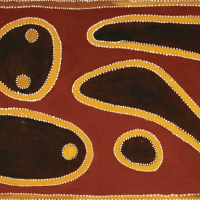62. ROVER THOMAS (JULAMA)

Rover Thomas Joolama (Julama) was born at Yalda Soak in the Great Sandy Desert near Kunawarritji (Gunawaggi or Well 33) on the Canning Stock Route, which runs north/south for over 1,000 kilometres in Western Australia. Now recognised as a colonial folly, the creation and management of the stock route caused the dislocation of Indigenous peoples from fifteen different language groups from their lands abounding its length.
Following his mothers death while still a child, Thomas was taken to be trained as a stockman in the Kimberley region at Billiluna (also Bilaluna, Billuluna) cattle station in the Tanami Desert, hundreds of kilometres north, between Balgo and Halls Creek. Later in life he settled at Warmun (Turkey Creek), where he pioneered the critically acclaimed East Kimberley painting movement (using natural ochres on ceremonial boards and then later on canvas) in the period 1979-1982.
Dingo Holes at Bilaluna is a striking work from 1995, the year Rover Thomas took his first trip back to his birth lands in forty years, and the year of the first significant showing of East Kimberley work in Brisbane, from which the present work was acquired.
A review of the 1995 Brisbane exhibition described the body of work on show as conceptually simple, powerfully tactile and robust.1 While the latter is certainly true and plainly obvious, the statement about East Kimberly arts simplicity reflects a cultural disconnect shown by early reviewers and critics of Indigenous art in general.
Dingo Holes at Bilaluna exhibits a striking and powerful feature of Thomas unique style his iconic, and singular, use of black2 within an oeuvre distinguished by virtuosity and compositional restraint but to describe the work as conceptually simple based on design belies the powerful personal and ancestral resonances inherent in the work.
Billiluna holds particular personal significance for the artist, for it was here that he was initiated into traditional law, and the Wild Dog or Dingo Dreaming sites from the artists traditional homelands are significant within this inheritance. The dogs importance is also linked to the origin of Thomas European first name: Waringarri Arts has documented that when Thomas first came to the East Kimberley as a young man, his fondness for talking about his Dingo/Wild Dog Dreaming led to the local Kija people nicknaming him Rover.3
Thomas approach has been described by National Gallery of Victoria curator Judith Ryan as fusing the cosmic with the concrete.4 In various renditions of the Wild Dog/Dingo Dreaming, Thomas paints the Dreaming place of the Mother Wild Dog linked to its babas or puppy dogs by subterranean passages (not depicted). Also sometimes depicted are rockholes atop ridges, represented by small circles, which were vital sources of water, as well as important places in associated Dreamings.
Thomas received recognition of his importance and status amongst the countrys premier contemporary artists with selection as Australias representative to the 44th Venice Biennale (along with Trevor Nickolls) in 1990, the first Indigenous artists to be so honoured. This was followed shortly thereafter by winning the acquisitive McCaughey Prize (Art Gallery of New South Wales, Sydney). Since then, two major public gallery solo exhibitions have been dedicated to the artist: Roads Cross, The Paintings of Rover Thomas, in 1994, and the posthumous I want to Paint in 2003/2004.5
As befits his standing as one of the countrys greatest artists, Thomas is represented in all major Australian national and state and territory public art galleries as well as the Berndt Museum of Anthropology, University of Western Australia, and many significant private national and international collections including The Laverty Collection, Sydney, The Holmes a Court Collection, Perth, The Kelton Foundation, Santa Monica, USA, the Muse du Quai Branly, Paris, France, and the AAMU, Aboriginal Art Museum Utrecht, in the Netherlands.
Footnotes
1. Art from the East Kimberleys, Savode Gallery, Brisbane, 9 June-1 July 1995, (organised by Waringarri Aboriginal Arts, WA). The artist is pictured in front of the present work in the review by Sue Smith, 'Vigorous Works Still Keep Cultural Identity', Courier-Mail, Brisbane, 9 June 1995
2. In 1995 the artist revisited his birthplace and the Wild Dog Dreaming sites for the first time in 40 years and created a body of work based on the trip. This story is recounted on paperwork accompanying Wurritji Country, a print that refers to Mother Wild Dog and her Dreamtime Puppy Dogs
3. Playwright Louis Nowra has written: his use of blackness takes on an iconic power ... rarely has black been used so powerfully ... throughout his career Thomas's use of black is so singular, so flamboyant..., in 'Blackness in the art of Rover Thomas', Art and Australia, Vol.35, No.1, 1997, p. 99
4. Rover and Queenie, National Gallery of Victoria 22 May-8 August 2000 (flyer, unpaginated)
5. I want to Paint (Art Gallery of New South Wales, Sydney, 2004 and The Ian Potter Centre, National Gallery of Victoria, Melbourne, 2003); and Roads Cross, The Paintings of Rover Thomas (National Gallery of Australia, Canberra), 1994
Jane Raffan
BA Hons. (Fine Arts); Grad.Dip. Environmental Law (Ethical Dealing Art & Cultural Heritage)